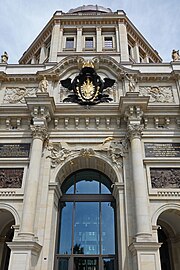Berlin Palace
| Berlin Palace | |
|---|---|
Berliner Schloss | |
 The west and north façades of the reconstructed Berlin Palace. Completed in 2020, the palace now houses theHumboldt Forummuseum. | |
 | |
| General information | |
| Status | Rebuilt |
| Architectural style | Baroque |
| Location | Berlin(Mitte), Germany |
| Coordinates | 52°31′03″N13°24′10″E/ 52.51750°N 13.40278°E |
| Construction started | 1443 (original) 2013 (reconstruction) |
| Completed | 1894 (original) 2020 (reconstruction) |
| Demolished | Damaged by Allied bombing in 1945, demolished by East German authorities in 1950 |
| Client | |
| Design and construction | |
| Architect(s) |
|
TheBerlin Palace(‹See Tfd›German:Berliner Schloss), formally theRoyal Palace(‹See Tfd›German:Königliches Schloss)[1]and also known as theCity Palace(‹See Tfd›German:Stadtschloss),[2]is a large building adjacent to theBerlin Cathedraland theMuseum Islandin theMittearea ofBerlin.It was the mainresidenceof theHouse of Hohenzollernfrom 1443 to 1918. Expanded by order ofFrederick I of Prussiaaccording to plans byAndreas Schlüterfrom 1689 to 1713, it was thereafter considered a major work ofPrussianBaroque architecture.[3]The royal palace became one of Berlin’s largest buildings and shaped thecityscapewith its 60-meter-high (200 ft)domeerected in 1845.
Used for various government functions after the abolition of the monarchy in the1918 revolution,the palace was damaged during theAllied bombing in World War II,and was razed to the ground by theEast Germanauthorities in 1950.
In the 1970s, the East German authorities erected amodernistparliament building on the site, known as thePalace of the Republic.AfterGerman reunificationin 1990, and years of debate, particularly regarding the fraught historical legacy of both buildings, the Palace of the Republic was itself demolished in 2009.
Most of the Berlin Palace's exterior was reconstructed beginning in 2013 to house theHumboldt Forummuseum. The east façade of the reconstructed palace incorporates a modernist design, while the new interior combines both historicist and modernist elements. ArchitectFranco Stellaoversaw the project and the exterior reconstruction was completed in 2020, with the last decoration being mounted in 2023. The palace is now again among thelargest in the world.
Overview
[edit]
The palace was originally built in the 15th century, but had changed in form throughout the next few centuries. It bore features of theBaroquestyle; its shape, which had been finalized by the mid-18th century, is for the most part attributed to German architectAndreas Schlüter,whose first design is likely to date from 1702, even though the palace incorporated earlier parts as seen in 1688 byNicodemus Tessin the Younger.It was the principal residence and winter residence of theHohenzollernkings of Prussia from 1701 to 1918. After theunification of Germanyin 1871, it also became the central residence for the German Emperors, who also served as the kings of Prussia. After the proclamation of theWeimar Republicin 1918, the palace became a museum. In World War II, the building was heavily damaged by Allied bombing. Although it is thought to have been repairable, the palace was demolished in 1950 by the East German authorities following much criticism. In the 1970s, thePalace of the Republicwas constructed on its site. After controversial public discussions, in 2002 theBundestagdecided to demolish the Palace of the Republic in order to make place for a partial reconstruction of the Berlin Palace.
Located on Spree Island, the plans envisaged the reconstruction of three sides of the palace exterior in the original style, initially without theNational Kaiser Wilhelm Monumentat the west front facing the riverSpree,and a modernist façade facing other branch of the Spree. The identically reconstructed facades include various remnant sculptures and stones of the original palace. The inner courtyard facades are also modern, except three facades of the main courtyard which was originally built in 1699 (Schlüterhof). The floorplan has been designed to allow future reconstruction of notable historical rooms. Part of the building houses the Humboldt Forum museum and congress complex, and was finished in 2020.[4][5]
History
[edit]History up to 1871
[edit]The palace replaced an earlier fort or castle guarding the crossing of the Spree atCölln,a neighbouring town which merged with Berlin in 1710. The castle stood on Fishers' Island, as the southern end of theMuseum Islandin the Spree is known. In 1443Frederick II"Irontooth",Margrave and Prince Elector of Brandenburg,laid the foundations of Berlin's first fortification in a section of swampy wasteland north of Cölln. At the completion of the castle in 1451, Frederick moved there from the town ofBrandenburg.The main role of the castle and its garrison in this period was to establish the authority of the margraves over the unruly citizens of Berlin, who were reluctant to give up their medieval privileges to a monarchy. In 1415 KingSigismundhadenfeoffedthe Hohenzollern princes with Brandenburg, and they were now establishing their power and withdrawing privileges which the cities had attained in the Brandenburg interregnum of 1319–1415.

In 1454 Frederick II, after having returned viaRomefrom his pilgrimage toJerusalem,made the castle chapel a parish church, richly endowing it with relics and altars.[6]Pope Nicholas VorderedStephan Bodecker,then Prince-Bishop of Brandenburg,to consecrate the chapel toErasmus of Formiae.[7]On 7 April 1465, at Frederick's request,Pope Paul IIattributed toSt Erasmus Chapelacanon lawCollegenamedStift zu Ehren Unserer Lieben Frauen, des heiligen Kreuzes, St. Petri und Pauli, St. Erasmi und St. Nicolai.Thiscollegiate churchbecame the nucleus of today'sEvangelicalSupreme Parish and Collegiate Church (Berliner Dom(Berlin Cathedral)), adjoining the site of the castle.
In 1538, the ElectorJoachim IIdemolished the castle and engaged the master builderCaspar Theissto build a new and grander palace in theItalian Renaissancestyle. After theThirty Years War(1618–1648),Frederick William,the "Great Elector", embellished the palace further. In 1688,Nicodemus Tessin the Youngerdesigned courtyard arcades with massive columns in front. Not much is known about the alterations of 1690–1695, whenJohann Neringwas the court architect.Martin Grünbergcontinued the alterations in 1695–1699.
In 1699, the ElectorFrederick III of Brandenburg(who took the titleKing in Prussiain 1701, becoming Frederick I), appointed the architectAndreas Schlüterto execute a "second plan" in the Italian manner. Schlüter's first design probably dates from 1702; he planned to rebuild the palace in the ProtestantBaroquestyle. His overall concept in the shape of a regular cube enclosing a magnificently ornamented courtyard was retained by all the building directors who succeeded him. In 1706, Schlüter was replaced byJohann Friedrich Eosander von Göthe,who designed the western extension of the palace, doubling its size. In all essentials, Schlüter's balanced, rhythmic composition of the façades was retained, but Göthe moved the main entrance to the new west wing.
Frederick William I,who became king in 1713, was interested mainly in building up Prussia as a military power, and dismissed most of the craftsmen working on the Stadtschloss. As a result, Göthe's plan was only partly carried out. The palace was namely the original location for theAmber Roomin theCatherine PalaceofTsarskoye SelonearSaint Petersburg,butPeter the Greatof Russia admired it during a visit, and in 1716 Frederick William I presented the room to Peter as a gift.[8]Nevertheless, the exterior of the palace had come close to its final form by the mid-18th century. Interior decoration continued, engaging the talents ofGeorg Wenzeslaus von Knobelsdorff,Carl von Gontardand many others. The final stage was the erection of the dome in 1845, during the reign ofFrederick William IV.The dome was built byFriedrich August Stülerafter a design byKarl Friedrich Schinkel.
The Stadtschloss was itself the epicenter of theRevolution of 1848in Prussia. Huge crowds gathered outside the palace to present an "address to the king" containing their demands for a constitution, liberal reform and German unification. Frederick William IV emerged from the palace to accept their demands. On 18 March, a large demonstration outside the palace led to bloodshed and the outbreak of street fighting. Frederick William later reneged on his promises and reimposed an autocratic regime. From that time onwards, many Berliners and other Germans came to see the palace as a symbol of oppression and "Prussian militarism".
-
The Renaissance residence (palace) in the 17th century (as painted byAbraham Begeyn)
-
The newly built residence (replacement palace) in 1702 (as depicted bySchenk). Note the missing dome, added only in 1845.
-
The BaroqueSchlüterhof,interior courtyard of the palace (painting byGaertner,1830)
-
Schlüter's Staircase (Gigantentreppe), built from 1699 (pictured in 1889)
History during the German Empire, Weimar Republic and Nazi Era (1871–1945)
[edit]In 1871, KingWilhelm Iwas elevated to the status ofGerman Emperor(Kaiser) of a united Germany, and the Stadtschloss became the symbolic heart of theGerman Empire.The Empire was (in theory) a constitutional state, and from 1894 onwards, the newReichstagbuilding, the seat of the German parliament, came to not only rival, but overshadow the Stadtschloss as the Empire's centre of power. In conjunction with Germany's defeat inWorld War I,KaiserWilhelm IIwas forced to abdicate, both as German Emperor and as King of Prussia.
In November 1918, during the immediate vacuum of power following the abdication of the Kaiser,SpartacistleaderKarl Liebknechtdeclared a German socialist republic from a balcony of the Stadtschloss. It was an attempt to steer theGerman revolutiontowards a communist Germany and stood in contrast to the proclamation of a republic thatPhilipp Scheidemannof theSocial Democratic Partyhad made a few hours earlier from a balcony of theReichstag building.Theduelling proclamationsunderscored that the more than 400 years of royal Hohenzollern occupation of the Berlin Palace had come to an end.[9]
During theWeimar Republic,parts of the Stadtschloss were turned into a museum, while other parts continued to be used for receptions and other state functions. UnderAdolf Hitler'sNational Socialist (Nazi) Party,which laid to rest monarchist hopes of a Hohenzollern restoration, the building was mostly ignored. During World War II, the Stadtschloss was twicestruck by Allied bombs:on 3 and 24 February 1945. On the latter occasion, when both the air defences and fire-fighting systems of Berlin had been destroyed, the building was struck by incendiaries, lost its roof, and was largely burnt out.
-
EmperorWilhelm IIopening theReichstagin the White Hall of the Berlin Palace, 1888 (painting byAnton von Werner,1893)
-
The palace's portrait gallery viewed towards the White Hall,c. 1900
-
The palace's west and south façades seen from across theSpreein 1920
-
Aerial view of the palace,c. 1905–1925.In the upper right is the Kaiser Wilhelm National Memorial.
Postwar debate and demolition
[edit]The end of the war saw the Stadtschloss a burned-out shell of its former glory, although the building remained structurally sound and much of its interior decoration was still preserved. It could have been restored, as many other bombed-out buildings in Central Berlin later were. The area in which it was located was within theSoviet zone,which became theGerman Democratic Republic.The building was used for a Soviet war movie ( "the Battle of Berlin" ) in which the Stadtschloss served as a backdrop, with live artillery shells fired at it for the realistic cinematic impact.[10]
The new socialist government declared the Stadtschloss a symbol of Prussian militarism, although at that time there appeared to be no plans to destroy the building. Some parts of it were in fact repaired and used from 1945 to 1950 as an exhibition space. A secret 1950 GDR Ministry of Construction report, only rediscovered in 2016, calculated that reconstruction of the damaged Palace could be achieved for 32 millionEast German marks.[11]But in July 1950Walter Ulbricht,the new General Secretary of the Central Committee of theSocialist Unity Party of Germany,announced the demolition of the palace. Despite objections, its removal commenced in September 1950, the process taking four months and consuming 19 tons of dynamite.[12]
So solid was its construction that the dome and its entire mount remained intact even after the rest of the building fell to the ground.[13]Only one section was preserved, a portal from the balcony from whichKarl Liebknechthad declared the German Socialist Republic. In 1964 it was added to theState Council Building,with an altered cartouche, where it forms the main entrance. The empty space where the Stadtschloss had stood was named Marx-Engels-Platz and used as a parade ground.
From 1973 to 1976, during the government ofErich Honecker,a large modernist building was built, thePalast der Republik(Palace of the Republic), which occupied most of the site of the former Stadtschloss.
-
The Schlossplatz with the burned out palace in 1945, after theFall of Berlin
-
The demolition of the Schlüterhof, up to this point still largely preserved, 1950
-
The Marx-Engels-Platz on the former ground of the palace and Schlossplatz, 1951
-
The front façade of thePalast der Republikin 1986 fromUnter den Linden
Reunification
[edit]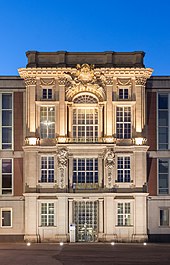
Shortly beforeGerman reunificationin October 1990, the Palast der Republik was found to be contaminated withasbestosand was closed to the public. After reunification, the Berlin city government ordered the removal of the asbestos, a process which was completed by 2003. In November 2003, the German federal government decided to demolish the building and leave the area and the adjacent Marx-Engels Platz (renamed Schlossplatz) as parkland, pending a decision as to its future. Demolition started in February 2006 and was completed in 2009.
The demolition was lengthy because of the presence of additional asbestos, and because the palace acted as a counterbalance to the Berliner Dom, across the street, on the unstable grounds of the Museum Island.[14]East Germans resented the demolition, especially those for whom the Palace of the Republic had been a place of fond memories, or who felt a sense of dislocation in a post-Communist world.[15]
From 2008, until the commencement of construction in 2013, the large area of the original Schlossplatz became a grassed field, laid out on minimal lines, with wooden platforms. At the same time, the Berlin Monument Authority (Landesdenkmalamt) undertook extensive archaeological excavations. Parts of cellars that had been situated in the south-west corner of the former Palace were discovered and it was decided these would be preserved and made accessible to visitors as an "archaeological window".[16]
Reconstruction
[edit]The debate
[edit]Following reunification, a 20-year-long debate commenced as to whether the palace should be reconstructed, and whether this should be in part or whole. Pro-reconstruction lobby groups argued that the rebuilding of the Stadtschloss would restore the unity and integrity of thehistoric centreof Berlin, which includes theBerliner Dom,theLustgarten,and the museums ofMuseum Island.Opponents of the project included those who advocated the retention of thePalast der Republikon the grounds that it was itself of historical significance; those who argued that the area should become a public park; and those who believed that a new building would be apasticheof former architectural styles, would be an unwelcome symbol of Germany's imperial past, and would be unacceptably expensive for no definite economic benefit. Opponents also argued that it would be impossible to accurately reconstruct the exterior and interiors of the building as neither detailed plans nor the necessary craft skills were available. Others disputed this, claiming that sufficient photographic documentation of both existed when the palace was converted to a museum following 1918.[citation needed]
The ideological divide was epitomized by two opposing groups. The Association for the Preservation of the Palace of the Republic (Verein zur Erhaltung des Palastes der Republik) championed a renovation of the GDR building that would incorporate a re-creation of the principal western facade of the City Palace, for a multipurpose "people's center" similar to theCentre Pompidouin Paris. The Berlin City Palace Sponsoring Association (Förderverein Berliner Stadtschloß) argued for the complete external reconstruction of the City Palace, as they considered it the only option that would restore the aesthetic and historic ensemble of Berlin's heart;[17]it also rejected suggestions that the proposed meticulous reconstruction would be an unauthentic "Disney" replica, as most centuries-old stone buildings are, by dint of aging and repair, at least partial reconstructions; and arguing that the allegation that the present time can only represent itself in its own architectural language, is simply ideology. The Sponsoring Association also drew attention to the observation in theVenice Charterthat "historic edifices have a material age and an immaterial significance": an importance that transcends time and that, provided sufficient documentation for a truly authentic copy exists, justifies their reconstruction to preserve a vital part of urban identity and historical memory.[17]
-
The site of the palace in 2007, with thePalast der Republikbeing demolished and theFernsehturmin the background
-
TheHumboldt Boxseen from the dome ofBerlin Cathedral,13 September 2011
-
Trial section of the reconstructed façade, 18 August 2012
-
View of the reconstruction site from the Humboldt Box, 21 April 2013
Towards construction and additional reconstructions
[edit]An important driving force behind the reconstruction was businessmanWilhelm von Boddien.[18][19]In 1992, he andKathleen King von Alvensleben[20]founded, what evolved to be the Berlin City Palace Sponsoring Association – which became the most influential lobby group. The Association accumulated plans that had been believed lost, and funded a research project atTechnische Universität Berlinto measure surviving photos and drawings of the palace to create precise architectural plans. In 1993, on the world's largest scaffolding assembly, it audaciously erected atrompe-l'œilmockup of two frontages of the Stadtschloss façade on a 1:1 scale on plastic sheeting. Privately funded by donations and sponsorship, thiscoup de théâtrestood for a year and half. Showing a vision of central Berlin lost for fifty years, and how the palace could provide the missing link to the historical ensemble of theZeughaus,theAltes Museum,and theBerlin Cathedral,the spectacle brought the debate to a temporary climax in 1993–94.[21][22]While opinion continued to remain divided, the association succeeded in winning over many politicians and other key figures to its efforts.[23]
In view of the previous opposition, including high cost, and most importantly, the psychological and political objections, successive German governments had declined to commit themselves to the project. However, by 2002 and 2003, cross-party resolutions of theBundestagreached a compromise to support at least a partial rebuilding of the Stadtschloss.
In 2007, the Bundestag made a definitive decision about the reconstruction. According to this compromise, which had been drawn up by a commission, three façades of the palace would be rebuilt, but the interior would be a modern structure to serve as a cultural museum and forum. An architectural competition was held, and in 2008 the jury chose the submission by the Italian architectFranco Stella.[24]Some of the internal spaces in Stella's design follow the exact proportions of the original state rooms of the palace; this would allow for their reconstruction at a later date should this be desired. The reconstruction also reproduces the original metre-thick width of the outer walls. These have been rebuilt as a sandwiched construction as follows: an inner retaining wall of concrete, followed by a layer of insulation, and an outer wall of brick, sandstone and stucco which replicates the original. Reconstruction of the Renaissance-gabled Pharmacy Wing, which connected to the Stadtschloss on the north side, would be another possible future project.
German government budget cuts delayed the construction of the "Humboldtforum", as the new palace was titled. Thefoundation stonewas finally laid by PresidentJoachim Gauckin a ceremony on 12 June 2013 which heralded the launch of a €590 million reconstruction project.[25]
In 2017, there was a debate whether to feature a cross on the dome of the palace, in relation to adhering historical accuracy or secularism.[26]Afterwards, a statue ofAntinouswas installed on the palace façade in the Schlüterhof courtyard.[27]However, the cross was installed on the top of the dome on 29 May 2020.[28]
-
Reconstruction work under way, 20 April 2016
-
The dome under reconstruction, 11 June 2016
-
Scaffolding on the south façade, 3 November 2018
-
The inner courtyard, 3 November 2018
-
The dome topped by a cross, installed on 29 May 2020
On completion in 2020, the building housed a museum containing collections of African and other non-European art, as well as two restaurants, atheatre,a cinema, and an auditorium.[29]
In July 2022, the bronze reliefs originally made byOtto Lessingin 1897 and mounted in 1903 were reconstructed and mounted on the Eosander Portal, the originals (like many of the exterior designs), having vanished after the demolition of the City Palace. These were soon followed by the mounting of the reconstructed plaques with the words ofFrederick II, Elector of Brandenburg,andFrederick I of Prussia,the first Prussian king.[30]
The surrounding area around the Berlin Palace which included the graniteAdlersäule(Eagle Pillar), the bronzeRossebändiger(Horse Tamers), and theNeptunbrunnen(Neptune Fountain), collectively called the Schlossplatz, were planned to be redesigned by 2023 in a modern way, that will still be able to bring back the mentioned original items surrounding the palace if desired. These terrace designs ended up being implemented in a more modernistic design, different than the more ornate original design. In front of the Schlossplatz is planned theDenkmal für Freiheit und Einheit(Monument to Freedom and Unity).[31]
In early April 2023, the Große Cartouche (Great Seal), was mounted on the center of the Eosander Portal, marking the completion of the façade decorations on Portal III.[32]
-
The palace with the reconstructed bronze reliefs and plaques on the portal initially designed by the architect Eosander[a]
-
Closeup of the Eosander portal
-
South and east façades of the palace, housing theHumboldt Forum
-
Foyer of the Humboldt Forum
See also
[edit]References
[edit]Footnotes
[edit]- ^TheFernsehturm Berlin,the antenna visible in the upper left, is not part of the palace grounds.
Citations
[edit]- ^"Berliner Schloss – Die Hohenzollern-Fassade".Deutschlandfunk Kultur.18 August 2021.
- ^"Berliner Schloss".Die Geschichte Berlins(in German).
- ^Georg Dehio:Handbuch der Deutschen Kunstdenkmäler, Berlin.Deutscher Kunstverlag,Munich 2006,ISBN978-3-422-03111-1,p. 63. (German)
- ^"So verlief das Richtfest am Berliner Schloss (Topping-out wreath ceremony at the Palace, German article)".Der Tagesspiegel Online.Retrieved13 June2015.
- ^Weltkunst (16 December 2020)."Eröffnung der Dritte Palast".
- ^Ingo Materna and Wolfgang Ribbe,Geschichte in Daten – Brandenburg,Munich and Berlin: Koehler & Amelang, 1995, p. 68.ISBN3-7338-0188-1.
- ^Wolfgang Gottschalk,Altberliner Kirchen in historischen Ansichten,Würzburg: Weidlich, 1985, p. 171.ISBN3-8035-1262-X
- ^Wermusch, Günter (1991).Die Bernsteinzimmer Saga: Spuren, Irrwege, Rätsel(in German). Yale University.ISBN978-3861530190.
- ^"Long Live the Republic-November 9, 1918".Deutsche Welle.16 November 2009.
- ^Renate Petras,Das Schloss in Berlin: Von der Revolution 1918 bis zur Vernichtung 1950,Berlin: Verlag Bauwesen, 1999, p. 110.ISBN3-345-00690-1
- ^"Geheimes Gutachten: Krimi um die Sprengung des Berliner Schlosses".Bz-berlin.de.3 August 2016.Retrieved25 August2016.
- ^"Jetzt aufgetauchtes Gutachten belegt | DDR hätte Stadtschloss für 32 Millionen Mark retten können".Bild.de.4 August 2016.Retrieved29 August2016.
- ^Photo: Köhler, Gustav; 15 October 1950; Bundesarchiv, Bild 183-08 103-0025
- ^"Palast-Abriss dauert länger und wird teurer als geplant".DIE WELT.11 December 2006.Retrieved2 December2020.
- ^Stubbs, John H.; Makaš, Emily G. (2011).Architectural Conservation in Europe and the Americas.John Wiley & Sons.
- ^Rettig, Manfred (2013).The Berlin Palace Becomes The Humboldt Forum.Humboldt Forum Foundation.
- ^abGoebe,Rolf J.Berlin's Architectural Citations: Reconstruction, Simulation, and the Problem of Historical Authenticity,PMLA, Modern Language Association of America, 2003
- ^Frederick Studemann (13 September 2019)."Berlin's Stadtschloss and the trouble with history".Financial Times.Retrieved19 January2023.
- ^Whitney, Craig R. "A Berlin Palace Stirs in Its Grave". The New York Times, 12 July 1993.
- ^"Rebuilding the Past?".dw.27 November 2008.Retrieved19 January2023.
- ^"Berlin's City Palace Controversy Refuses to Die".Dw.Retrieved7 June2017.
- ^Whitney, Craig R. (12 July 1993)."A Berlin Palace Stirs in Its Grave".The New York Times.ISSN0362-4331.Retrieved23 August2016.
- ^Oswalt, Philipp (1 February 2008)."Das Stadtschloss-Geschäft"[The Berlin Palace Business].Bauwelt(in German). pp. 7–8.Retrieved7 June2017.
- ^Werning, Remei CapdevilaFrom Berliner Stadtschloss to Humboldt-Box and Back Again: Architecture in the Conditional,Universitat Autònoma de Barcelona
- ^Harriet Alexander (12 June 2013)."Berlin begins reconstruction of King Frederick the Great's palace".The Telegraph.Retrieved14 June2013.
- ^"Berlin squabbles over cross on City Palace reconstruction".DW.21 May 2017.
- ^"A copy is a copy is an original!".Humboldt Forum.9 August 2017.[permanent dead link]
- ^"Cross causes controversy atop reconstructed Berlin Palace".DW.29 May 2020.
- ^"Berlin Palace Rebuilding Begins 63 Years After Explosion – Bloomberg".Bloomberg News.Archived fromthe originalon 7 December 2014.Retrieved6 March2017.
- ^"Weitere Rekonstruktion: Die bronzenen Reliefplatten am Eosanderportal wurden montiert".Förderverein Berliner Schloss E.V.29 July 2022.
- ^"Officials finally break ground on Berlin's 'seesaw' reunification monument".The Architect's Newspaper.1 June 2020.
- ^"Das ist der Krönung! Berlin Schloss erhält Portalschmuck für 2. Mio. Euro".Die Stimme Berlins.3 April 2023.
Bibliography
[edit]- Albert Geyer:Geschichte des Schlosses zu Berlin (1443–1918).Nicolai Verlag, Berlin 2010.ISBN978-3-89479-628-0.(German)
External links
[edit]- Berlin Palace Association(in English)
- Donation website
- Buildings and structures completed in 1451
- Houses completed in the 15th century
- Houses completed in 1845
- Buildings and structures in Mitte
- Palaces in Berlin
- Royal residences in Berlin
- Demolished buildings and structures in Germany
- Demolished buildings and structures in Berlin
- Prussian cultural sites
- Buildings and structures in Berlin destroyed during World War II
- Building reconstruction projects in Germany
- Rebuilt buildings and structures in Berlin
- Former palaces in Germany
- Proposed museums
- Buildings and structures demolished in 1950
- Frederick I of Prussia



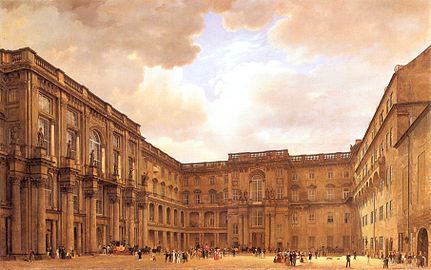


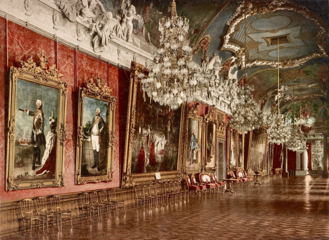










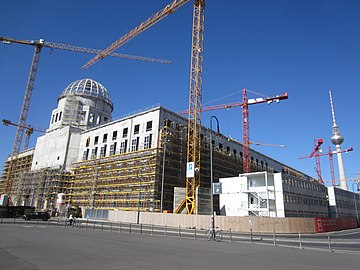


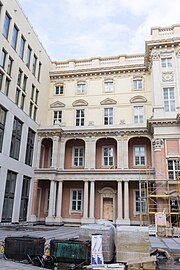

![The palace with the reconstructed bronze reliefs and plaques on the portal initially designed by the architect Eosander[a]](https://upload.wikimedia.org/wikipedia/commons/thumb/0/0c/Berlin-BerlinerSchloss-6-Asio.JPG/405px-Berlin-BerlinerSchloss-6-Asio.JPG)
